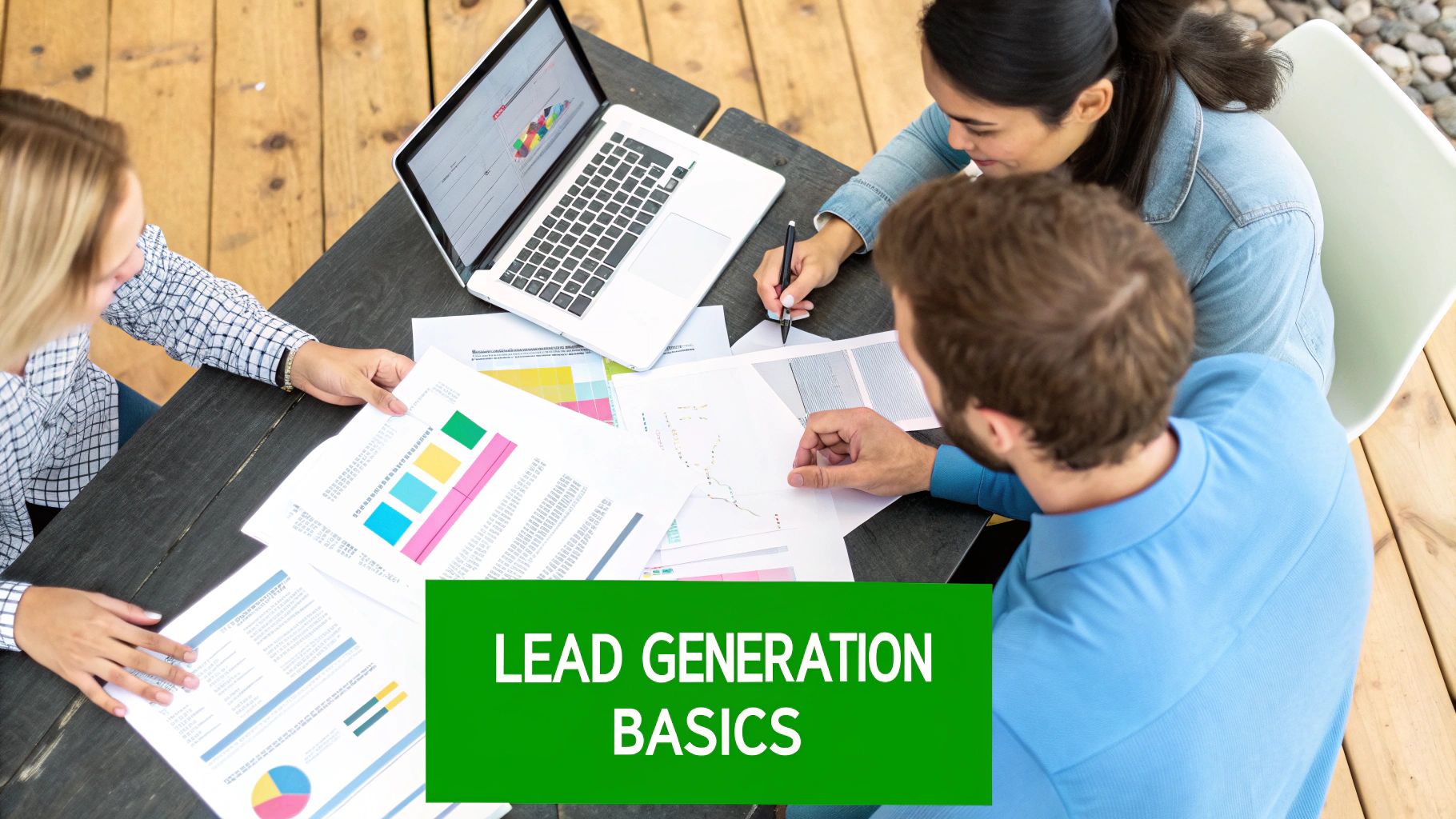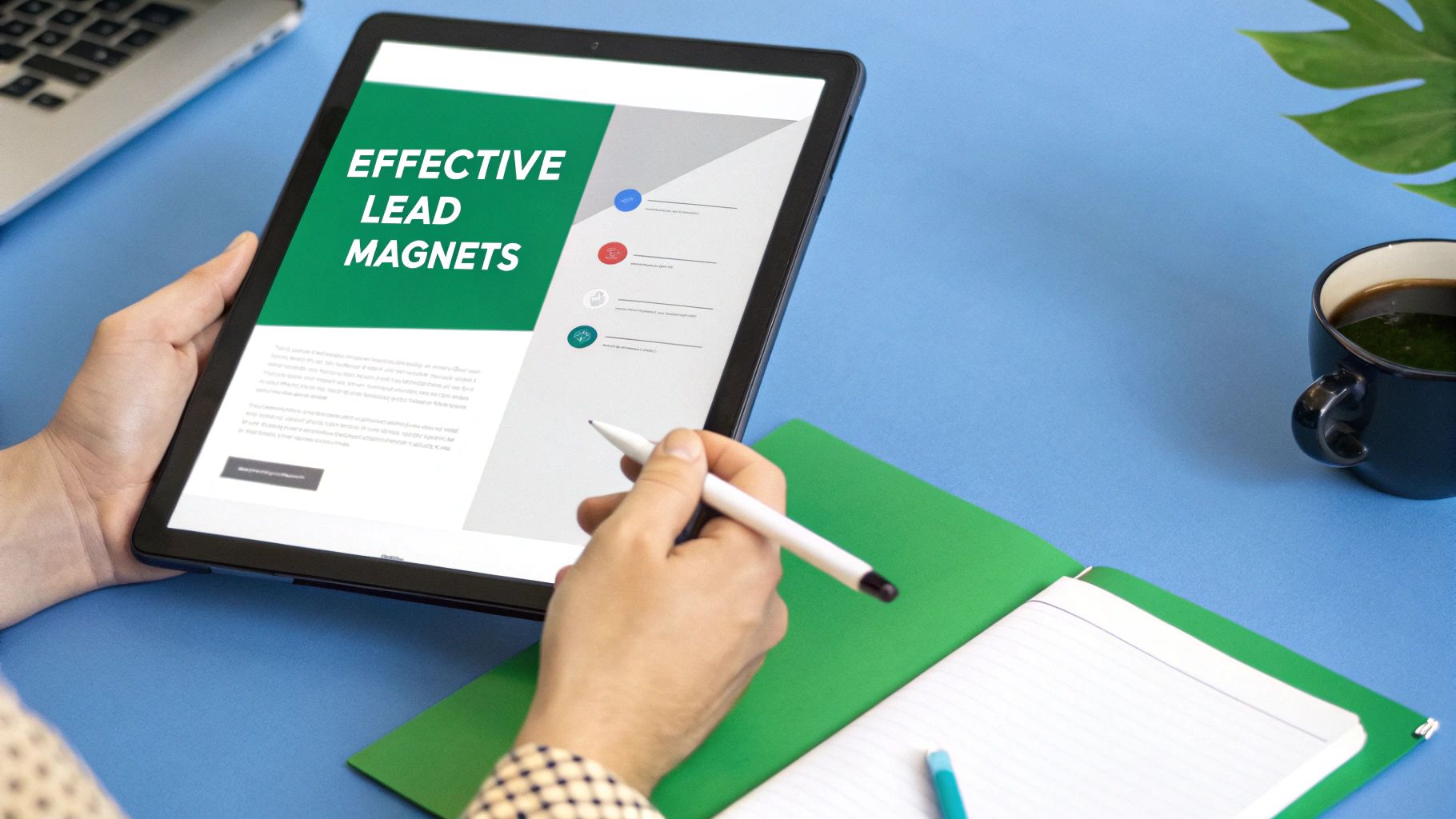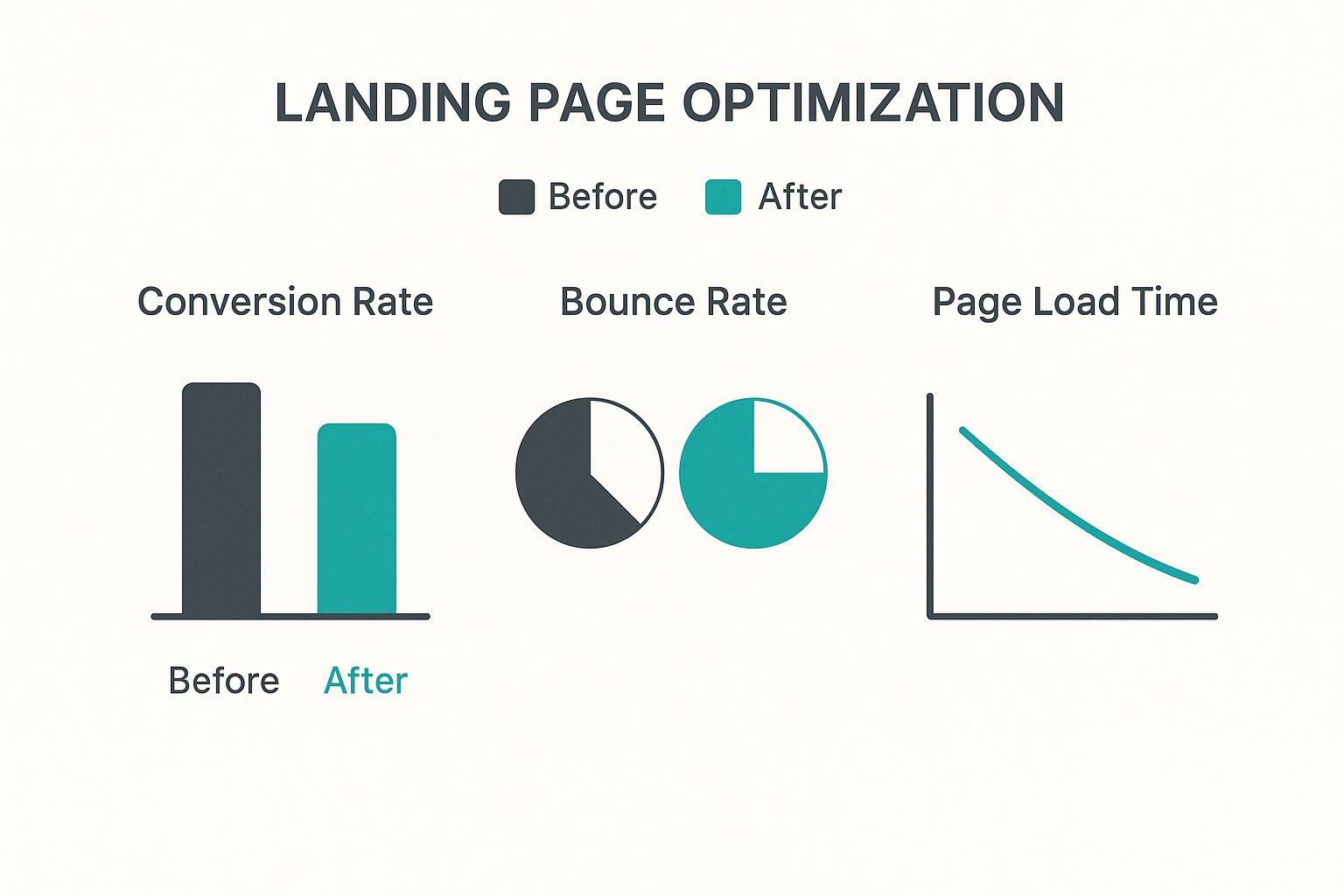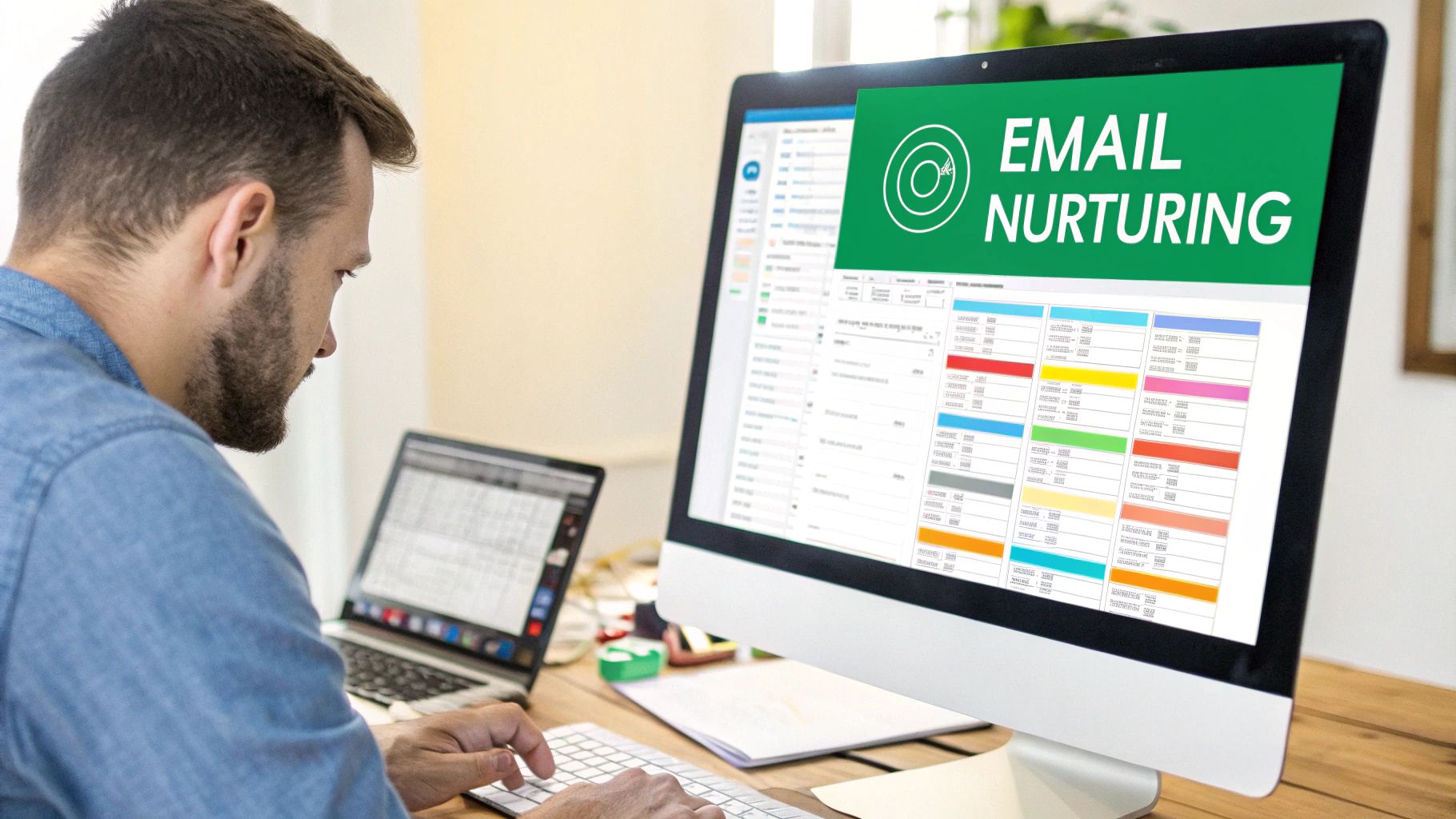How to Generate Leads That Actually Convert
Generating leads really comes down to three things: spotting buyer intent signals, meeting prospects on the digital channels they actually use, and building a qualification process that doesn't waste anyone's time. This isn't about reinventing the wheel, but it is about moving past outdated tactics to create a sustainable system for growth by focusing on prospects who are already looking for a solution.
Beyond Cold Calls: A Modern Lead Generation Framework

Let’s be real: the old playbook for finding customers just doesn’t cut it anymore. Endless cold calls and generic email blasts aren't just inefficient; they're actively harming your brand's reputation. Today, generating leads requires a much smarter, more integrated framework.
This means shifting from a "push" mentality—where you interrupt prospects—to a "pull" strategy that naturally draws them in. The goal isn't just to collect a list of contacts. It's to build a reliable pipeline of high-quality leads who have already signaled they're interested in solving a problem you can fix.
The Pillars of Modern Lead Generation
A successful lead generation engine is built on a few essential pillars. When you get these right, you create a system that consistently delivers results without relying on aggressive, low-return tactics. This isn't just theory; it's a practical roadmap.
Here are the key components:
- Spotting Buyer Intent: This is all about monitoring digital channels for clues that a person or company is actively researching a solution like yours. It could be anything from someone asking a question on Reddit to a key job change announced on LinkedIn.
- Meeting Them Where They Are: Your audience is online. A solid strategy engages them on the platforms they already trust, whether that's a professional network, a niche forum, or your own website.
- Creating a Seamless Qualification Process: Not every lead is ready for a sales call. A strong process automatically scores and segments leads, making sure your sales team's time is spent on conversations with the highest potential.
The core idea is simple: stop chasing contacts and start attracting conversations. When you focus on prospects who are already raising their hands, your outreach becomes a helpful solution, not an unwanted interruption.
For businesses in the B2B space, this approach is especially critical. You can dive deeper into the fundamentals in our beginner's guide to B2B lead generation. An integrated framework ensures you’re not just generating leads, but generating leads that are ready to become valuable, long-term customers.
Using Social Channels to Find B2B Buyers
Let’s get one thing straight: telling a sales team to "just be active on LinkedIn" is terrible advice. Social media isn’t just a digital bulletin board for company updates; it’s a living, breathing source of buyer intent signals. The real magic happens when you treat professional networks like a tactical playbook, pinpointing high-quality B2B leads who are already signaling they need a solution.
This isn’t about passive networking. It’s about actively hunting for specific triggers—think company growth spurts, fresh funding announcements, or key leadership changes—that tell you an organization is ready to buy.
Mastering LinkedIn Sales Navigator for Precision Targeting
LinkedIn Sales Navigator is so much more than a premium badge on your profile. If you know how to wield it, it’s a powerful lead generation engine. Forget basic keyword searches; the goal here is to build hyper-targeted lists based on timely events that scream, "We have a new problem to solve!" This is how you find prospects who aren’t just a good fit, but a good fit right now.
Start by zeroing in on "growth signals." These are the tell-tale signs that a company is expanding, and almost always, that means they’re investing in new tools.
Effective Sales Navigator Search Filters:
- Company Headcount Growth: Filter for companies that have bulked up their employee count by 10-20% or more in the last year. Rapid hiring almost always creates new operational headaches and opens up budgets for efficiency tools.
- Recent Funding Events: A company that just landed a Series A or B round has two things: fresh cash and a mandate to grow. You want to get in front of their decision-makers within the first 3-6 months of that announcement.
- Job Changes: A new VP of Sales or Head of Marketing isn’t going to sit around and maintain the status quo. They’re hired to make an impact, fast. Set up alerts for key title changes in your target accounts and be one of the first people to offer a solution that makes them look good.
This strategy completely flips the script on your outreach. You’re no longer a cold interruption. Instead, you're a timely expert responding to clear market movements.
Engaging in Industry Groups Without Being Salesy
LinkedIn Groups can be a goldmine, but only if you play the long game with a "give, give, ask" mentality. The objective isn't to carpet-bomb every thread with your product pitch. It's to build genuine authority and trust. Find the groups where your ideal customers are actually asking questions and sharing their daily headaches.
Your mission is to become the most helpful person in the room. Answer questions thoughtfully. Share useful resources (especially ones that aren't yours). Get into real discussions. Once you’ve built that credibility, you’ll see your profile views climb, and eventually, prospects will start reaching out to you.
The best way to sell in a group is to never sell at all. Be the go-to expert. Your helpfulness becomes your best marketing, attracting qualified people who already see you as a trusted advisor.
Crafting Outreach That Actually Starts a Conversation
After you've identified a solid lead, a generic "I'd like to connect" request is a waste of a click. Your first message has to be personal and immediately offer value. Reference the specific signal you saw—a recent post they shared, a company award, a mutual connection you both respect.
A Simple, Effective Outreach Template:
"Hi [Name], I saw your company just [mention the growth signal, e.g., secured a new round of funding for its AI development]. Huge congrats on the milestone!
Typically, when companies scale that fast, managing [mention a relevant pain point] becomes a top priority. I've helped a few other businesses in the [Their Industry] space navigate that exact challenge.
No pitch—just wanted to connect with another innovator in the field."
This approach works because it’s not threatening. It shows you did your homework and smoothly opens the door for a conversation about their actual problems.
Using LinkedIn Lead Gen Forms for Seamless Data Capture
If you're looking for a more scalable approach, LinkedIn Lead Gen Forms are incredibly powerful. LinkedIn is an absolute giant in the B2B space, with over one billion users. A huge 53% of B2B marketers are already on the platform hunting for prospects.
These forms plug directly into your ad campaigns and pre-fill a user's profile information, which drastically cuts down on friction. This simple feature is why they boast an impressive 13% average conversion rate—miles ahead of the typical 2-3% you see on website landing pages. If you want to dig deeper, check out these powerful LinkedIn statistics to grasp the platform's full potential.
By combining sharp targeting, authentic engagement, and low-friction conversion tools, you can turn social channels from a simple networking site into a predictable and powerful source for generating high-quality leads.
Turning Your Website into a Lead Generation Hub

Your website should be your best salesperson, working 24/7 to pull in and chat with potential customers. If it’s just a digital brochure, you’re leaving a massive opportunity on the table. The real goal is to turn it from a passive online pamphlet into an active, lead-capturing machine that keeps your sales pipeline full.
This isn't just a hunch; the data backs it up. A whopping 90.7% of marketers use their websites to capture leads, and 89.2% lean on their blogs to nurture those relationships. Email is still a powerhouse, too, with 69.2% of marketers using it to get results.
This tells us one thing loud and clear: your website is the center of your lead generation universe. Let's break down how to tune it up for maximum impact.
Create Irresistible Lead Magnets
A lead magnet is simply something valuable you offer for free in exchange for an email address. The trick is to create a resource so genuinely useful that your ideal customer doesn't think twice about the trade. Forget generic checklists—your offer needs to solve a real, nagging problem for your audience.
What keeps your ideal customers up at night? What piece of information would make their jobs easier or give them a quick win?
Here are a few ideas for high-value lead magnets:
- In-depth Whitepapers or Reports: Offer original research or a deep dive into an industry trend they can't just Google.
- Practical Webinars or Workshops: Host a live or on-demand session that teaches a tangible skill. For a SaaS company, this might be a workshop on "Mastering Advanced Features in Our Platform."
- Templates and Tools: Give them something they can use right now, like a pre-built project management template, a budget calculator, or a content calendar spreadsheet.
The point is to provide immediate value. A great lead magnet doesn't just get you a contact; it positions you as a helpful expert from the very first hello.
Strategically Place Your Calls to Action
A brilliant lead magnet is useless if nobody can find it. Your call-to-action (CTA) is the bridge between your content and your offer, guiding visitors to take that next step. Where you put these CTAs is just as important as what they say.
Don't just slap a "Contact Us" button in your footer and call it a day. You need to sprinkle CTAs across your highest-traffic pages and within your most popular content.
Your best blog posts are prime real estate for lead generation. If an article gets thousands of views a month, it absolutely needs a relevant CTA that offers a "content upgrade"—a lead magnet specifically tied to that post's topic.
For example, if you wrote a blog post called "10 Ways to Improve Team Productivity," the perfect content upgrade is a downloadable "Ultimate Productivity Cheatsheet." Contextual offers like this convert at a much higher rate than a generic newsletter signup.
Build Automated Nurture Sequences
Getting the lead is just the start. The real magic is in the follow-up. An email nurture sequence is a pre-written series of automated emails designed to build a relationship, provide more value, and gently move a new contact from curiosity to sales-readiness.
When someone downloads your lead magnet, they shouldn't be met with silence. They should instantly get the first email in a planned sequence. This system ensures no one falls through the cracks and every new person gets a consistent, high-quality experience.
A Simple Nurture Sequence Framework:
- Immediate Delivery: The first email delivers the promised goods and says thanks. This needs to go out instantly.
- Value-Add: A few days later, send another email with a related piece of content, like a link to a relevant blog post or a short video tip. No sales pitch—just more help.
- Problem Agitation: In the next email, you can gently touch on the core problem your product solves. Maybe share a mini-case study or a customer success story.
- Soft Call-to-Action: Now you can introduce your solution. This is where you might offer a demo, a free trial, or a consultation, explaining how it directly solves the challenges you've been discussing.
By automating this process, you build a scalable system that warms up leads in the background. As you get more advanced, you can see how AI lead generation tools can personalize these sequences even further. This methodical approach is what turns your website from a simple online presence into a predictable source of qualified leads.
How to Qualify Leads Without Wasting Time
A flood of new leads feels great, but that feeling fades fast when your sales team gets stuck sifting through prospects who were never going to buy. The real art of lead generation isn't just about volume; it's about building a smart system that separates genuine buyers from the casually curious.
A rock-solid qualification process is what keeps your team focused on conversations that actually lead to closed deals. This isn't about putting up gates to keep people out. It's about creating clarity. When marketing and sales are on the same page about what a "good" lead looks like, everybody wins. Marketing sharpens its targeting, and sales invests its energy in relationships with real potential.
Frameworks for Smarter Qualification
Forget relying on gut feelings. The best sales teams use proven frameworks to run their discovery calls. These systems give you a repeatable way to uncover the critical details you need to decide if a prospect is a solid fit.
Two of the most common and effective frameworks are BANT and MEDDIC. They turn unstructured chats into strategic intelligence-gathering missions. You stop just talking about features and start digging into the problems that keep your prospect up at night.
A structured approach is essential, especially when you consider that 44% of sales reps say they're too swamped to properly follow up on the leads they get. Smart qualification is the only way to manage that flow. You can find more stats on the challenges of modern lead generation in this deep dive.
Comparing Lead Qualification Frameworks
Choosing the right framework depends on the complexity of your sales cycle. For many, BANT provides a quick, effective gut check. For more complex, high-value deals, MEDDIC offers the depth needed to navigate enterprise buying committees.
| Criteria | BANT (Budget, Authority, Need, Timeline) | MEDDIC (Metrics, Economic Buyer, Decision Criteria, Decision Process, Identify Pain, Champion) |
|---|---|---|
| Ideal For | Shorter, less complex sales cycles; transactional sales. | Complex, long-term enterprise sales with multiple stakeholders. |
| Focus | Quickly assessing the fundamental buying signals. | Deeply understanding the customer's internal buying process and political landscape. |
| Key Questions | "Is there a budget for this?" "Who makes the final call?" |
"What metrics will define success?" "Who holds the purse strings?" "Who is our internal champion?" |
| Strength | Simplicity and speed. Easy for new reps to learn and apply. | Thoroughness. Uncovers potential deal-killers early and identifies key allies. |
| Weakness | Can be too simplistic for large deals; budget might not be defined early. | Can feel overly rigorous for smaller deals; requires significant investigation. |
Ultimately, both frameworks push you to ask the hard questions early, preventing you from sinking dozens of hours into a deal that was doomed from the start.
Building an Automated Lead Scoring System
While frameworks guide your conversations, an automated lead scoring system can qualify prospects before they even talk to a human. This is where you assign points to leads based on who they are and what they do, creating a simple score that signals how ready they are to talk to sales.
This all happens quietly in the background of your CRM, adding and subtracting points as a lead engages with your company.
Who They Are: Demographic and Firmographic Scoring
This is all about how well a lead matches your Ideal Customer Profile (ICP). You're rewarding the attributes that your best customers share.
- Job Title: A "VP of Sales" might get +15 points, but an "Intern" only gets +1.
- Company Size: If you sell to businesses with 50-200 employees, leads in that sweet spot get +10 points.
- Industry: A prospect from a key industry like "Fintech" could earn +10 points.
What They Do: Behavioral Scoring
This side of the score tracks a lead's actions, which are powerful signals of their interest level.
- High-Intent Actions: Big moves like requesting a demo or visiting your pricing page could be worth +20 points.
- Medium-Intent Actions: Actions like subscribing to a newsletter or joining a webinar might get +10 points.
- Low-Intent Actions: Simple things like opening an email might only be worth +2 points.
Once a lead hits a certain score—let's say 100 points—they get automatically flagged as a Marketing Qualified Lead (MQL) and sent over to sales. It’s a data-driven handoff that’s far more reliable than someone manually sorting through a list. It also shows why the old spray-and-pray tactics are so ineffective; it's critical to understand why old-school cold outreach doesn't work anymore.
This data-driven approach ensures your reps engage right when a prospect's interest is peaking.

The numbers here are crystal clear: small technical improvements, like making your site faster, have a direct and powerful impact on keeping potential leads from bouncing away.
Weaving Lead Alerts into Your Sales Workflow

Catching a lead is just the starting line. The real race happens in the moments that follow—that critical window between a prospect showing interest and your sales team actually reaching out. Get this wrong, and the deal is likely lost before it ever began. Speed isn't just a nice-to-have; it's the foundation of modern sales.
Leaving a hot, qualified lead to go cold in a CRM queue is like letting a customer stand in an empty shop while your staff chats in the back. You need to bridge the gap between marketing qualification and sales engagement, and you need to do it instantly. This isn't about working harder; it’s about building a smarter, faster workflow.
Building Your Automated Notification Engine
The secret is to connect your lead scoring triggers directly to your team’s communication tools. Platforms like HubSpot and Salesforce are brilliant for this. You can set up rules that fire off a notification the exact second a lead’s score hits a certain number, signaling they’ve graduated from a Marketing Qualified Lead (MQL) to a Sales Qualified Lead (SQL).
Let’s say a prospect downloaded a whitepaper, visited your pricing page three times, and then requested a demo. Their lead score just shot up by 50 points, pushing them past your "sales-ready" threshold of 100. Instead of waiting for someone to manually review a list, an automated workflow should kick in immediately.
The whole point is to cut out the manual handoff. Your system should act as a digital dispatcher, assigning the lead and blasting out an alert without a single person having to lift a finger. This ensures follow-up happens in minutes, not hours.
Choosing the Right Alert Channel
How you send the alert is just as important as what triggers it. Sure, email notifications are the old standby, but they easily get buried in a crowded inbox. For real, right-now speed, you need to push alerts into the platforms your sales team already lives and breathes in all day.
Common Notification Channels and When to Use Them:
- Slack or Microsoft Teams: Perfect for high-priority alerts that need immediate eyes. A dedicated
#new-leadschannel can create a live feed of opportunities for the whole team. - CRM In-App Notifications: Tools like Salesforce can pop up a notification or create a task right on a rep’s dashboard. This keeps everything inside their main workspace.
- Email Alerts: Still useful as a backup or for sending a daily summary of all new leads.
Most teams find a hybrid approach works best. A high-priority Slack ping for a demo request, combined with an automated task created in the CRM, makes sure nothing ever falls through the cracks.
Don’t just send an alert; send an assignment. The notification shouldn't just say, "Here's a new lead." It should say, "This is your new lead, and here’s everything you need to know to call them right now."
Crafting the Perfect Lead Alert
A notification without context is just noise. A truly effective lead alert is a compact, actionable briefing that gives a sales rep everything they need for a relevant, informed first conversation. It’s the difference between a cold follow-up and a warm, contextual outreach.
Your alerts should be set up to pull key data points directly from the lead's record. This gives your rep instant intel without them having to click through five different screens to figure out what’s going on.
What Every Lead Alert Must Have:
- Lead Name and Company: The basics.
- Lead Source: How did they find you? A LinkedIn ad? Organic search? This shapes the first sentence of their outreach.
- Recent High-Intent Activity: What specific action triggered this alert? ("Visited pricing page," "Requested demo," "Downloaded 'Enterprise Solutions' case study.")
- Lead Score: The number that tells the rep just how hot this lead is.
- A Direct Link to the CRM Record: Give them a one-click path to dive deeper and start logging their activity.
Here’s what this looks like in a real-world Slack notification:
🔥 New Sales-Qualified Lead! 🔥
- Name: Jane Doe
- Company: Acme Corp
- Source: Organic Search (Blog Post)
- Trigger Action: Demo Request
- Lead Score: 125
- CRM Link:
[View in Salesforce]
This simple, scannable message turns a generic ping into a powerful sales tool. It equips your team with the right information at precisely the right moment, empowering them to engage the second a lead’s interest peaks. That’s how you dramatically increase your odds of turning a spark of interest into a closed deal.
A Few Common Lead Generation Questions
As you get deeper into lead generation, you're bound to run into a few tricky questions. Building out a solid strategy always brings up challenges and strategic debates among the team. This is where we tackle some of the most common ones I hear, giving you the clarity to refine your approach and get better results.
It's all about moving past surface-level metrics to really get what's working and why. Let's dig into the questions that pop up when teams get serious about finding new customers.
What Is the Most Effective Channel for B2B Lead Generation?
While the perfect channel always comes down to your specific industry and audience, LinkedIn consistently proves its worth for B2B. Nothing else really comes close for reaching specific decision-makers. Its professional focus and deep user data let you zero in on prospects by job title, company size, and even recent growth signals.
But here’s the thing: the best results almost never come from just one place. A really powerful strategy combines LinkedIn outreach with strong website content, targeted email nurturing, and even getting involved in niche online communities. The goal is to create multiple touchpoints and meet your ideal customers on the platforms they’re already using to find solutions.
How Long Should It Take to Convert a Lead?
This is the classic "it depends" question. The timeline for converting a lead can swing wildly based on your product’s price, its complexity, and how many people need to sign off on the purchase. A simple SaaS tool might close in just a few weeks.
On the other hand, a complex enterprise software sale can easily stretch out for several months. On average, the journey from first contact to a signed deal takes about 64.5 days, but it’s crucial to set expectations based on your own market. This is exactly why consistent, automated lead nurturing is so important—it keeps you top-of-mind and builds trust throughout that longer buying cycle.
A longer sales cycle isn't a sign of failure; it's a reality of complex B2B sales. The key is to maintain engagement and provide value at every stage, ensuring you're the first choice when the buying decision is finally made.
How Do I Measure the Success of My Efforts?
Success in lead generation is about way more than just counting the number of leads you get. A huge volume of low-quality leads can actually hurt your business by wasting your sales team’s precious time. To get a real sense of how your program is doing, you need to track a few key performance indicators (KPIs) that measure both quantity and quality.
Key Metrics for Lead Generation Success:
- Cost Per Lead (CPL): This tells you exactly how much you're spending to acquire each new lead, helping you figure out how efficient your marketing campaigns are.
- MQL to SQL Conversion Rate: This measures the percentage of marketing-qualified leads that your sales team accepts as sales-qualified. It’s a vital sign of lead quality and shows how well your marketing and sales teams are aligned.
- Lead-to-Customer Conversion Rate: This is the ultimate bottom-line metric. It shows you what percentage of your leads eventually become paying customers, revealing the true return on your investment (ROI).
Ready to stop searching for leads and start having them delivered to you? Intently uses AI to monitor social channels for high-intent conversations, sending qualified prospects directly to your inbox. Find customers who are ready to buy at https://intently.ai.
